The beheading of John the Baptist is a biblical event commemorated as a holy day by various Christian churches.
Head of John the Baptist may also refer to:
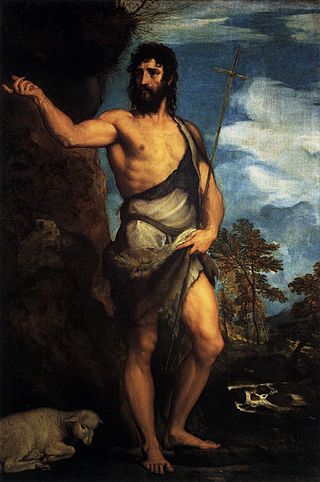
John the Baptist was a Judaean preacher active in the area of the Jordan River in the early 1st century AD. He is also known as Saint John the Forerunner in Eastern Orthodoxy, John the Immerser in some Baptist Christian traditions, Saint John by certain Catholic churches, and Prophet Yahya in Islam. He is sometimes alternatively referred to as John the Baptiser.

Salome, also known as Salome III, was a Jewish princess, the daughter of Herod II, who was the son of Herod the Great, with princess Herodias. She was granddaughter of Herod the Great, and stepdaughter of Herod Antipas. She is known from the New Testament, where she is not named, and from an account by Flavius Josephus. In the New Testament, the stepdaughter of Herod Antipas demands and receives the head of John the Baptist. According to Josephus, she was first married to her uncle Philip the Tetrarch, after whose death she married her cousin Aristobulus of Chalcis, thus becoming queen of Armenia Minor.
Salome was the daughter of Herodias, and nemesis of John the Baptist.
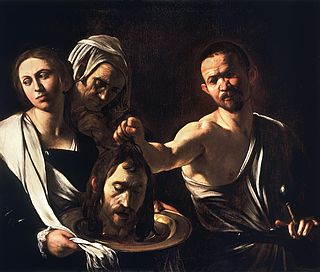
Salome with the Head of John the Baptist (London), c. 1607/1610, is a painting by the Italian master Caravaggio now in the collection of the National Gallery in London.
St. John's Day may refer to:

The beheading of John the Baptist, also known as the decollation of Saint John the Baptist or the beheading of the Forerunner, is a biblical event commemorated as a holy day by various Christian churches. According to the New Testament, Herod Antipas, ruler of Galilee under the Roman Empire, had imprisoned John the Baptist because he had publicly reproved Herod for divorcing his first wife and unlawfully taking his sister-in-law as his second wife Herodias. He then ordered him to be killed by beheading.
Events from the year 1609 in art.

Salomè is a 1986 Italian-French drama film directed by Claude d'Anna and starring Jo Champa. It is an adaptation of the 1891 Oscar Wilde play play of the same name, and was entered into the 1986 Cannes Film Festival.
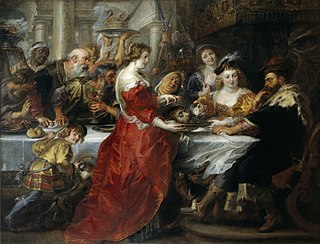
The Feast of Herod refers to the episode in the Gospels following the Beheading of St. John the Baptist, when Salome presents his head to her parents. The account in the Book of Mark describes Herod holding a banquet on his birthday for his high officials and military commanders, and leading men of Galilee. At this banquet, Herod's daughter dances before Herod, who is pleased and offers her anything she asks for in return. The girl asks her mother what she should request, and she is told to demand the head of John the Baptist. Reluctantly, Herod orders the beheading of John, and John's head is delivered to her, at her request, "on a platter."(Mark 6:17–29)

The St John Altarpiece is a large oil-on-oak hinged-triptych altarpiece completed around 1479 by the Early Netherlandish master painter Hans Memling. It was commissioned in the mid-1470s in Bruges for the Old St. John's Hospital (Sint-Janshospitaal) during the building of a new apse. It is signed and dated 1479 on the original frame – its date of installation – and is today still at the hospital in the Memling museum.
San Giovanni decollato is Italian for "the beheaded Saint John"
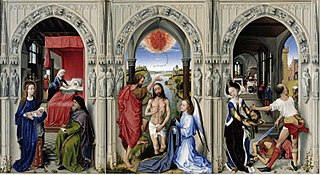
The St John Altarpiece is a c. 1455 oil-on-oak wood panel altarpiece by the Early Netherlandish painter Rogier van der Weyden, now in the Gemäldegalerie, Berlin. The triptych is linked to the artist's earlier Miraflores Altarpiece in its symbolic motifs, format and intention.

The Apparition(French: L'Apparition) is a painting by French artist Gustave Moreau, painted between 1874 and 1876. It shows the biblical character of Salome dancing in front of Herod Antipas with a vision of John the Baptist's severed head. The 106 cm high and 72,2 cm wide watercolor held by the Musée d'Orsay in Paris elaborates on an episode told in the Gospel of Matthew 14:6–11 and Mark 6:21–29. On a feast held for Herod Antipas' birthday, the princess Salome dances in front of the king and his guests. This pleased him so much he promises her anything she wished for. Incited by her mother Herodias, who was reproved by the John the Baptist for her illegitimate marriage to Herod, Salome demands John's head on a charger. Regretful but compelled to keep his word in front of everyone present, Herod complies with Salome's demand. John the Baptist is beheaded, his head brought on a charger and given to Salome, who in turn gives it to her mother.

San Giovanni Decollato is a Roman Catholic church in Rome, sited on via di San Giovanni Decollato in the Ripa rione, a narrow road named after the church. Its construction took most of the 16th century.
Salome with the Head of John the Baptist may refer to:

Salome Dancing before Herod is an oil painting produced in 1876 by the French Symbolist artist Gustave Moreau. The subject matter is taken from the New Testament, depicting Salome—the daughter of Herod II and Herodias—dancing before Herod Antipas.
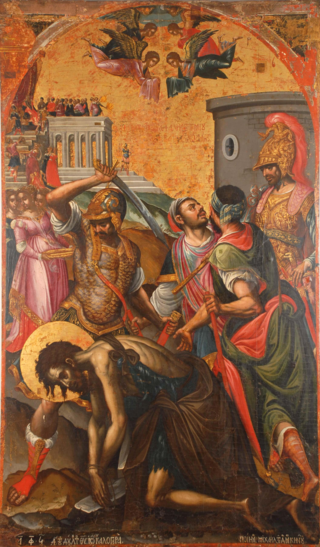
The Beheading of John the Baptist was a painting made of egg tempera and gold leaf. It was similar in length to Damaschino's Stoning of Stephen. Michele Damaschino was a famous member of the Cretan school of painting. His contemporaries were El Greco and Georgios Klontzas. Damaschino was from Crete, he spent a large amount of time in Venice. While in Venice, and other parts of Italy, he adopted Italian mannerisms which he applied to his painting technique. The Beheading of John the Baptist was a popular theme among Greek and Italian painters.

The Head of Saint John the Baptist presented to Salome is a circa 1609 oil on panel painting by the Flemish artist Peter Paul Rubens (1577-1640) executed shortly after his return to Antwerp after an eight year stay in Italy.
The beheading of John the Baptist is a biblical event commemorated as a holy day by various Christian churches.